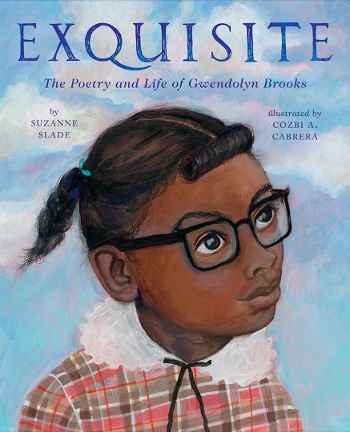The love Cozbi A. Cabrera possesses for Gwendolyn Brooks's groundbreaking work radiates in every image she creates for Exquisite. Her acrylic paintings burst with creativity and joy, mixing realism with expressionistic moments that provide whimsical visual flourishes.
 In her afterword for Exquisite: The Poetry and Life of Gwendolyn Brooks, artist Cozbi A. Cabrera talks about how she loved researching the life of legendary poet Gwendolyn Brooks. Cabrera thanks the staff at the University of Illinois at Urbana-Champaign's Rare Book and Manuscript Library for allowing her to hold and study Brooks's handwritten papers and notebooks. The love Cabrera possesses for Brooks's groundbreaking work radiates in every image she creates for Exquisite. Her acrylic paintings burst with creativity and joy, mixing realism with expressionistic moments that provide whimsical visual flourishes.
In her afterword for Exquisite: The Poetry and Life of Gwendolyn Brooks, artist Cozbi A. Cabrera talks about how she loved researching the life of legendary poet Gwendolyn Brooks. Cabrera thanks the staff at the University of Illinois at Urbana-Champaign's Rare Book and Manuscript Library for allowing her to hold and study Brooks's handwritten papers and notebooks. The love Cabrera possesses for Brooks's groundbreaking work radiates in every image she creates for Exquisite. Her acrylic paintings burst with creativity and joy, mixing realism with expressionistic moments that provide whimsical visual flourishes.
Cabrera keeps surprising the reader from spread to spread. She finds unique, idiosyncratic ways of telling Brooks's story, using Suzanne Slade's rich, poetic and straightforward text as a springboard to visually experiment, to add a playful spin to the author's words. Cabrera adds elements of folk art into the mix, perfect for a biography celebrating a poet who wrote, directly and humanely, in the voices of everyday people.
The first thing of note when looking at Exquisite is the beautiful cover, showing Brooks as a bespectacled child surrounded by clouds. She looks up with dreamy confidence. Flip the book over and an older Brooks appears, looking straight at the reader with stylized flowers appearing behind her. Open the book and the color pink welcomes the eye. The title page reveals a row of Chicago houses under pink clouds. This color will appear frequently throughout the book. And because Slade uses the poem "Clouds" (written by Brooks at age 15 and included in the back matter) as an inspiration for her telling, Cabrera fills many pages with cloud imagery.
The book's first spread places the reader outside a window, looking in at a young Gwendolyn peacefully reading, sitting on a floor next to a giant bookcase. Just look at those intricate details Cabrera includes. The flowers painted on the wall, the cozy chair's fabric, and oh, those books, all those glorious books. The warmth and serenity of this spread beautifully conveys how Brooks would fall in love with the written word as a child.
The next page introduces the members of Brooks's immediate family, with Gwendolyn and her mother watching dad joyfully read a poem out loud, book in hand. Gwendolyn's younger brother hugs father from behind, with a contemplative look on his face. Cabrera places the family in the foreground. The blue walls and the white ceiling above mirror the sky outside the window. Cabrera puts special care in depicting the flowery patterns on the couch and mom's dress. Every detail feels right and carefully researched.
The next spread offers a wonderfully cinematic moment showing mom reading one of Gwendolyn's poems, while the seven-year-old budding writer sits at a piano. Family photographs cover the wall. Cabrera captures the event in a long shot, allowing the reader to take in the mother's excitement as she reads her daughter's words. Mom stands elegantly, leaning forward, poem in one hand while the she extends her other arm, as if reading the most beautiful poem ever created. The next page shows Brooks sitting on her back porch, looking up at gorgeous pink clouds.
As Slade tells of young Brooks becoming a prolific poet, who eats and breathes writing, Cabrera starts becoming looser and more playfully surreal with her art. One double-page spread shows Brooks standing on a chair and hanging up her many poems on a clothesline. In a moment of controlled chaos, Cabrera fills the page with images (paper dolls, "ticktock clocks," raindrops) from these poetic endeavors. Another painting has Brooks standing on her bed, writing on one page while other pages swirl around her. Note that the bedroom's walls resemble the pink clouds. Another spread offers an overhead, time-lapsed shot of several young Gwendolyns busy writing various poems, in different positions, around the page (readers will see this image when they remove the book's cover).
Cabrera deftly moves back and forth between realism and expressionism during the book's second half. A realistically rendered and haunting moment of teenaged Gwendolyn feeling like an outsider, shyly walking by her Double Dutch-playing peers, is closely followed by a scene showing Brooks's feet climbing a mountain of poetry books as she heads to college.
Some paintings that seem fairly straightforward initially become slightly off-kilter with further investigation. For example, in the scene where Brooks and her newly wedded husband cut their wedding cake, Cabrera frames the action so the tops of their heads drift off the page. The reader views the action almost from a sideways angle, and this makes it all the more striking. The reader's eye is drawn to that giant wedding cake, Gwendolyn's red dress, and those ever-present books.
And yet Cabrera successfully works to create a cohesive artistic vision, bringing back recurring imagery to great effect. For example, as an older Gwendolyn mails one of her poems, she looks up at the clouds.
[Read the Horn Book Magazine review of Exquisite here]
Tying everything together visually is Cabrera's love for Brooks, and a dedication to being true to the poet's creative process as well as the world in which she lived. She makes sure to get everything correct — not just the emotional journey but the clothes, cityscapes (look at that moment with Gwendolyn standing near Chicago's Regal Theatre), and every pattern on every piece of furniture.
Exquisite contains my favorite joyous moment featured in a 2020 picture book. When Brooks hears that she has won the Pulitzer Prize, she and her son dance with extreme happiness. The looks on their faces and their body language are transcendent. Meanwhile, out the window colorful clouds grace the Chicago sky.
The image is truly exquisite — a perfect tribute to an amazing poet, created by an amazing artist.

ALREADY A SUBSCRIBER? LOG IN
We are currently offering this content for free. Sign up now to activate your personal profile, where you can save articles for future viewing.








Add Comment :-
Comment Policy:
Comment should not be empty !!!
Sam Juliano
I am catching up with some reviews from last year's Calling Caldecott series, as the chaos from the pandemic pulled me away from my normal viligence. This is a stupendous review, a stellar piece of scholarship for an exquisite picture book biography, one deserving of the wide praise bestowed on it. I love the way you suggest a cinematic quality and the alternating panels of realism and expressionism. Similarly I couldn't agree with you more on that unforgettable moment when Brooks wins the Pulitzer Prize and also the mention of the book's cover, which is a real treasure in that department. But the entire review leaves not a single stone un-turned, and I too really adore this book! Bravo!Posted : Sep 18, 2021 01:56